
Original Link: https://www.anandtech.com/show/2399
Thermaltake Muse R-Duo: External RAID
by Dave Robinet on December 14, 2007 2:00 AM EST- Posted in
- Storage
Introduction
RAID, while initially overused in desktop configurations, has found a more stable home among knowledgeable users over the past year. Where "RAID 0" became a buzzword equaling "high performance" some years ago, the trend has recently shifted towards people researching their decisions and acting accordingly. These informed consumers have begun to notice that indeed, not all RAID implementations are equal - some controllers perform better than others do, and most importantly, some handle failures and other unexpected events much more smoothly. It is with this mindset that we turn our attention once again to some of the newer RAID offerings, beginning with a RAID enclosure from Thermaltake.
Thermaltake
Founded in 1999, enthusiasts recognize Thermaltake for their heat management portfolio (coolers, fans, etc). Indeed, the company has only recently moved into the storage arena - so recently, in fact, that their "Company History" page omits any mention of the product line. When browsing said line, however, it's clear that Thermaltake has had a lot of recent activity in this regard, and now offers products ranging from data cables through RAID enclosures. The question, obviously, is this: Is Thermaltake intentionally downplaying the presence of their storage offering due to lackluster performance, or do they have powerful weapons hidden in their storage arsenal? We'll look at their Muse R-Duo product, and see how it fares under a variety of conditions.
The Thermaltake Muse R-Duo RAID Enclosure
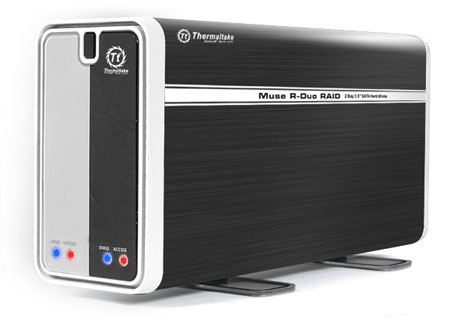
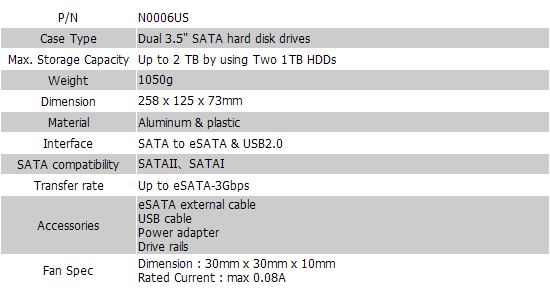
The Thermaltake Muse R-Duo is an external aluminum enclosure, housing up to two SATA hard drives. The unit is made primarily of aluminum, both for the frame as well as the brushed aluminum housing. Rather than relying solely on the aluminum housing to dissipate the (often substantial) heat generated by two active hard drives, Thermaltake has opted to put a 30mm fan on the back of the enclosure, providing both active and passive cooling. The unit can rest on either its side, or using the rotating stand found at the bottom of the device.
Muse R-Duo, Continued
The Muse R-Duo is an intelligent RAID offering, meaning the hard drive(s) appear to the host system as a single physical drive. The enclosure handles all RAID functions - RAID 0, RAID 1, stacked (or "big"), or linear - internally. In the case of the latter, the system can access the hard drives independently, foregoing any RAID benefits. Whichever option is chosen by the user (other than linear), the R-Duo configures the array internally, and presents a single volume to the host OS as a finished product. This cuts down substantially on the processing power required by the system, and makes this a "true" RAID product, differentiating itself from many competitors who simply put multiple drives in a single enclosure and call that RAID. Connectivity to the host system is via either USB 2.0 or eSATA, and the Muse supports hot-swapping.
In a slightly different twist on multiple drive enclosures, Thermaltake has opted to put the PCB in the center of the enclosure and mount the two hard drives in opposing fashion. This setup (rather than conventional methods, using a separate backplane) makes the enclosure itself somewhat smaller, but could potentially expose the PCB to more heat than it otherwise might experience.
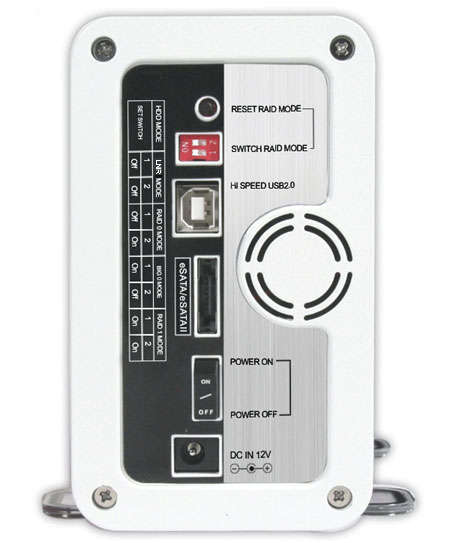
Another twist to the R-Duo is the use of dipswitches as a means to select which RAID function the device will provide. There are two of these switches on the back of the unit, along with writing on the case identifying what each combination will accomplish. The modes supported by the Muse R-Duo are:
Linear - The Muse exposes the drives as standard hard drives. RAID functions of the controller are disabled.
Big - The Muse combines both drives into a single, large volume (i.e. a variant of JBOD - Just a Bunch Of Disks). The drive capacities do not need to be matching, though there is no striping or other performance benefits. In this way, two older hard drives (i.e., a 200GB drive plus a 320GB hard drive) would form a single 520GB volume. The Muse uses the first drive until it's full and then begins writing to the second drive.
RAID 0 - In standard RAID 0 fashion, both drives are striped and combined to form a single volume. If the drives are of differing capacity, the Muse uses the smaller capacity on both drives, resulting in a total volume size double the capacity of the smallest hard drive found in the enclosure. Under normal circumstances, this is the highest performing RAID flavor available.
RAID 1 - One drive is used as the data access drive (the drive which "faces" the operating system), while a copy of the data is kept on a second drive (written to both drives at the same time, to ensure data integrity). If one of the drives fail, the volume remains available for use without interruption. The volume size is the capacity of the smallest hard drive in the array.
Note: The initial release of the Muse R-Duo had a capacity limit of 750GB per drive (1.5TB total). Newer models now support capacities of 1TB per drive, and Thermaltake updated their website to reflect this fact. Also, to read up on the full details of the RAID functions supplied by the Muse R Duo, please check our earlier RAID primer here.
Test Setup
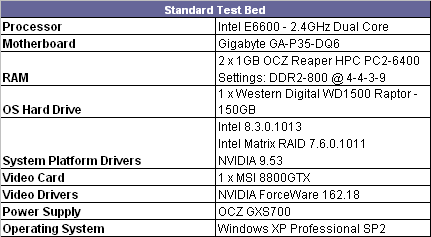
We are using an Intel E6600 dual-core CPU to ensure that we are not limited by computing power in our testing. We've used a 2GB memory configuration for these tests, but will soon be updating our test beds to a consistent 4GB platform due to current DDR2-800 pricing and upcoming game and application requirements. Our choice of budget level OCZ Reaper HPC PC2-6400 memory offers a very wide range of memory settings with timings of 4-4-3-10 used for our storage benchmark results.
The testbed uses an MSI 8800GTX video card and we run our tests at a resolution of 1280x1024. We run all of our tests with an enclosed case (in this instance, with the drives installed in the Muse R-Duo chassis) with a dual optical/hard drive setup to reflect a moderately loaded system platform. We fully update the OS and load a clean drive image for each platform in order to keep driver conflicts to a minimum.
We format the test drive before each test run and complete five tests on each drive to ensure consistency in the benchmark results. We drop the high and low scores and report the remaining (median) score. The Windows XP swap file is set to a static size of 2048MB and we clean the prefetch folder after each benchmark.
Our hard drive platform for this test is Seagate's Barracuda ES.2 1TB. This is the enterprise version of the 7200.11 drive that we already tested. Given the virtually identical performance characteristics of the two drives, we are confident in including the 7200.11 as a single-drive comparison platform.
Software Test Suite
With the variety of disk drive benchmarks available, we need a means of comparing the true performance of the hard drives in real world applications. Given that this is a review of a RAID product, rather than a pure hard drive review, we'll forego the gaming benchmarks in favor of some relevant RAID handling benchmarks. Our suite for this test will include:
- HD Tach
- HD Tune
- Acoustics and Thermals
- PCMark05
- XP Startup
- Application Loading
- Hard Drive Usage
- Virus Scanning
- File Write
- WinRAR
- Windows Vista Startup/Shutdown
- PCMark Vantage
- RAID Rebuild Operations and Error Handling
HD Tune and HD Tach
For HD Tune and HD Tach, we tested each of the configurations (RAID 0, RAID 1, Linear, and Big) of the Muse R-Duo independently to see what the low-level measurements would look like.
RAID 0
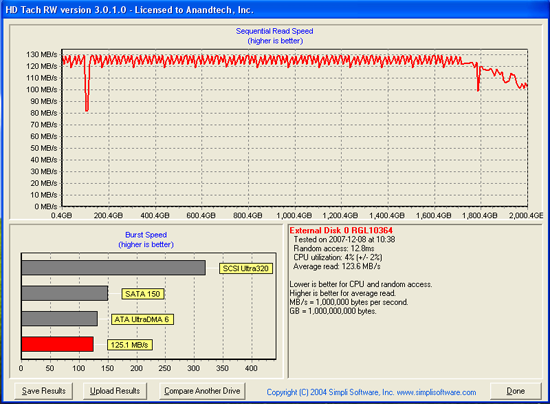 |
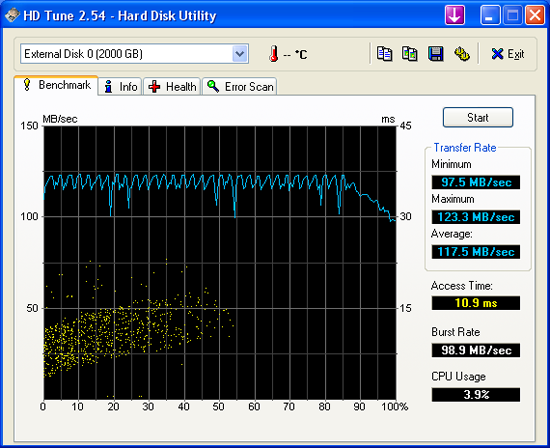 |
RAID 1
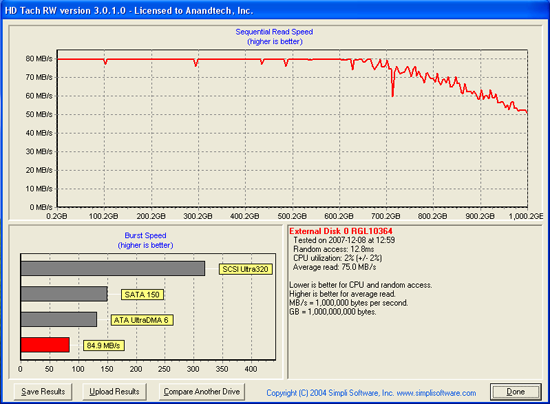 |
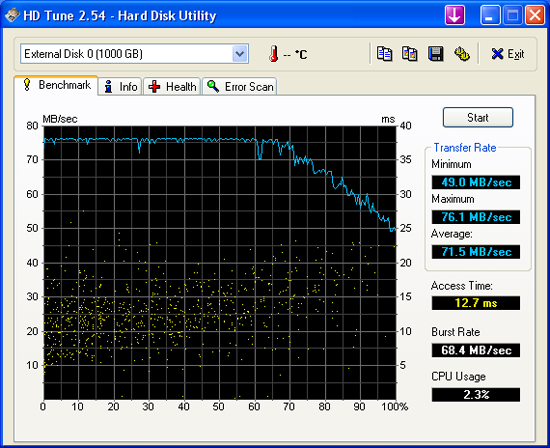 |
Linear
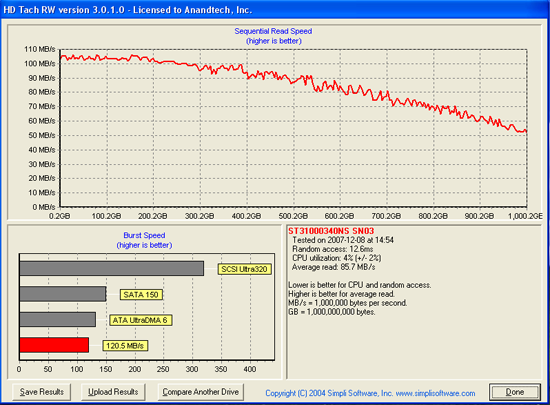 |
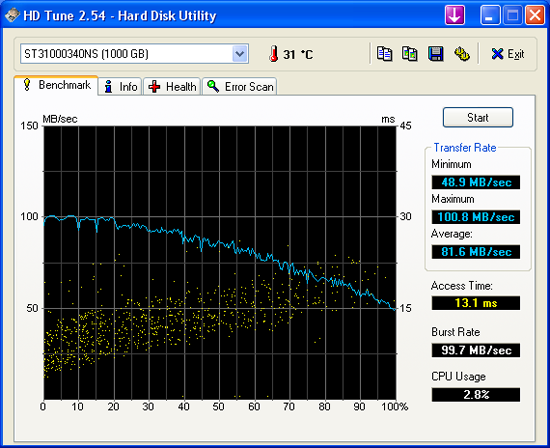 |
Big
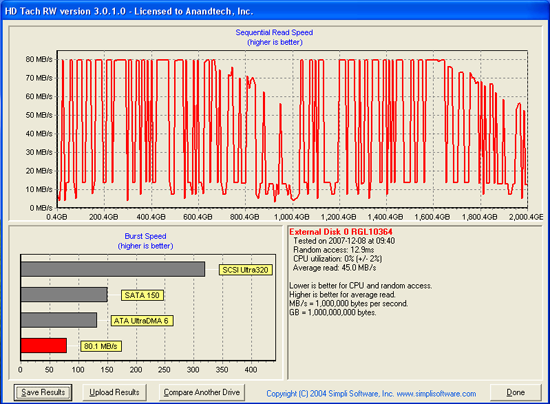 |
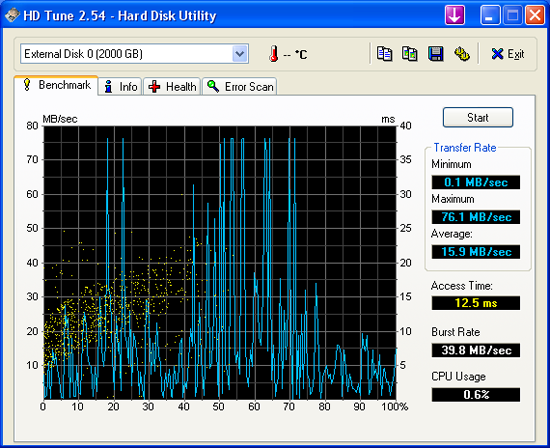 |
The most surprising result is the crazy synthetic performance of the Muse R-Duo in "Big" mode - the controller's performance is all over the map during both the HD Tach and HD Tune tests. Certainly, this result bears watching in future benchmarks. RAID 0 mode is somewhat underwhelming, producing synthetic results similar to what we encountered in our review of the desktop version of the Seagate drive in our 1TB Shootout article. Linear mode performs roughly the same as in the 1TB Shootout article as well, though CPU usage is ~2% lower.
RAID 1 mode is disappointing. Performance drops to nearly 2/3 of what we have come to expect from the Seagate drive, which is below our expectations. In RAID 1 mode, there is usually a certain amount of performance degradation, but not typically to this degree.
These benchmarks, far from predicting real-world performance, should be taken with an especially large grain of salt when looking at RAID benchmarks. Still, the results are interesting; keep the results (particularly Big mode) in mind when we look at the remainder of our benchmarks.
Acoustics
As this is an external device, we are able to take advantage of long cable runs to ensure that the Muse R-Duo is in a physically separate room from the host computer. We will test the unit under drive operating conditions, as well as separately to check the noise levels of the Thermaltake cooling solution.
For the drive operating portion, our acoustic tests measure the decibel levels while the system is at idle and under load while running the General Hard Disk Drive Usage benchmark within PCMark 2005. We found through trial and error that this particular benchmark produces controlled readings across a wide range of applications within the benchmark. This particular benchmark utilizes 60% reads and 40% writes within the trace playback file.
We take measurements at a distance of 5mm from the rear and front of the enclosure in order to minimize surrounding environmental noise. We have noticed that unless we run a completely silent system in a quiet room that measurements taken from 1m are generally not meaningful due to ambient noise levels. There are exceptions like the Raptor series of drives but overall most modern desktop drives are quieter now than the other components in the system while under load.
The reported measurements use an A-weighted decibel score that measures frequencies similar to the way the human ear responds to sound. We take three measurements for each test. We then subtract the high and low scores and arrive at our findings by reporting the remaining score.
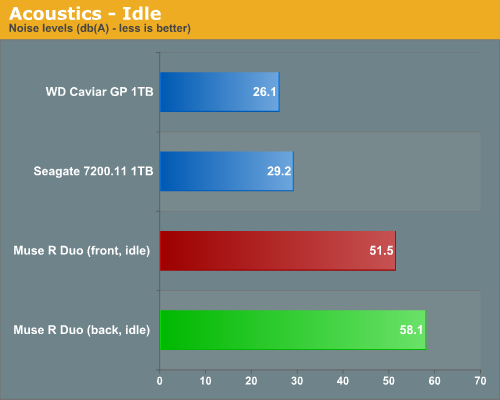
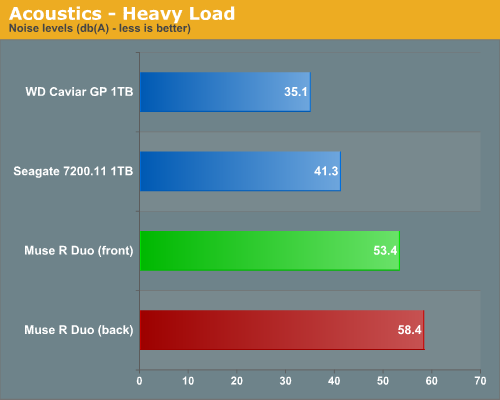
The Muse R-Duo is far from silent, with the small fan blowing a significant amount of air through the enclosure. The noise actually reverberates in the enclosure somewhat, making it that much louder. Even under heavy load, the fan completely obscures the sound of the hard drives.
Thermals
Our thermal tests utilize sensor readings via the S.M.A.R.T. (Self-Monitoring, Analysis and Reporting Technology) capability of the drives, gathered using the Active SMART 2.6 utility. Note that we upgraded from version 2.42, which we used in our previous tests; in re-running several benchmarks we were able to confirm that no results changed as a result of the update. We also utilize thermal sensors and infrared measurement devices to verify our utility results. We test our drives in an enclosed case environment without the fans operational to simulate running in a near silent SFF or HTPC case design. We typically find the reported numbers drop anywhere from 18% to 25% when the case fans are operational. Our base temperature level in the room at the time of testing was 25C.
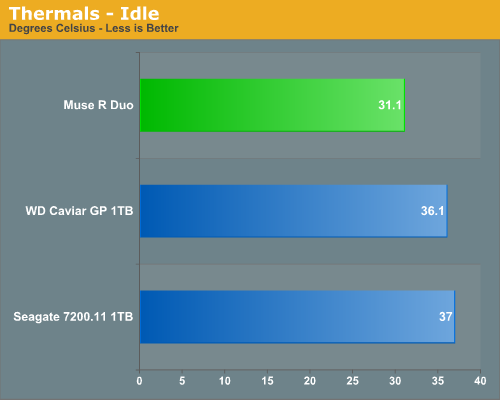
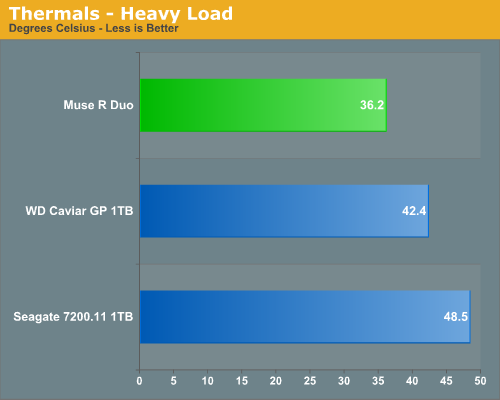
The Muse R-Duo does a very good job keeping the two Seagate drives cool - its loaded temperature comes in beneath the idle temperature we observed in our normal benchmark procedure when testing the bare drive. Note again that we conduct the system test without case fans operational, so it reflects a far worse scenario. Still, having the hard drives run that cool while sitting nearly adjacent to each other is an impressive feat, and a testament to the pedigree of strong cooling that Thermaltake brings to the table. The acoustic results and temperature results are two sides of the same coin, of course: louder fans creating airflow reduce temperatures and a lack of fans and airflow causes them to rise.
PCMark05
We use the HDD test suite within PCMark05 for further comparative hard disk scores as it provides a mixture of actual application results and specific read/write percentages used by these programs. The program utilizes the RankDisk application within the Intel iPEAK SPT suite of tools to record a trace of disk activity during usage of real world applications. PCMark05 then replays these traces to generate performance measurements based upon the actual disk operations within each application. The HDD test suite contains 53% read and 47% write operations with each trace section utilizing varied amounts of read or write operations. Our test results use the following trace runs:
Windows XP Startup: This test consists of 90% reading and 10% writes which tracks XP activities at start-up.
Application Loading: This test consists of 83% reading and 17% writes and tracks the opening and closing of the following programs.
- Microsoft Word
- Adobe Acrobat Reader
- Windows Media Player
- 3Dmark 2001SE
- Leadtek WinFast DVD
- Mozilla Internet Browser
General Hard Disk Drive Usage: This test consists of 60% reading and 40% writes which monitors application usage utilizing the following settings.
- Opening a Microsoft Word document, performing grammar check, saving and closing.
- Compression and decompression using WinZip
- Encrypting and decrypting a file using PowerCrypt
- Scanning files for viruses using F-Secure Antivirus
- Playing an MP3 file with Winamp
- Playing a WAV file with Winamp
- Playing a DivX video using DivX codec and Windows Media Player
- Playing a WMV video file using Windows Media Player
- Viewing pictures using Windows Picture Viewer
- Browsing the Internet using Microsoft Internet Explorer
- Loading, playing and exiting a game with Tom Clancy's Ghost Recon
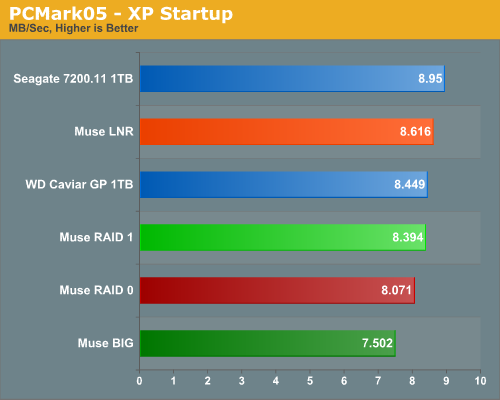
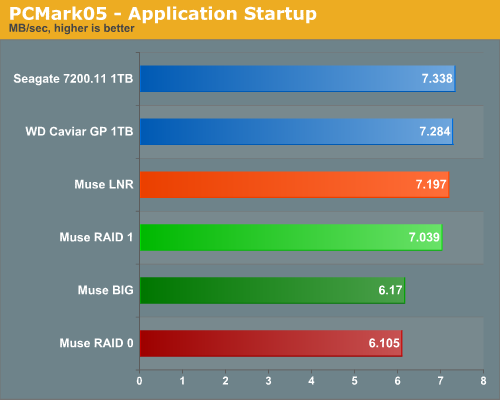
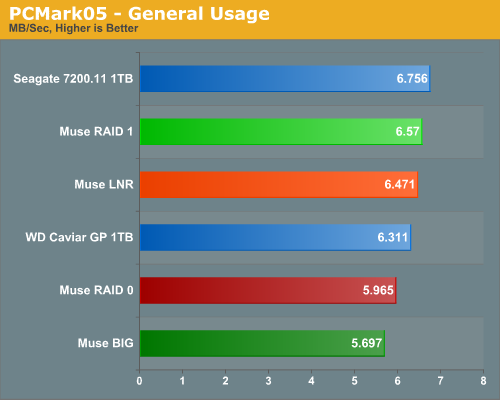
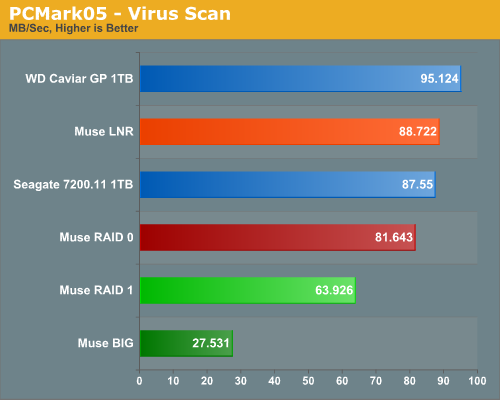
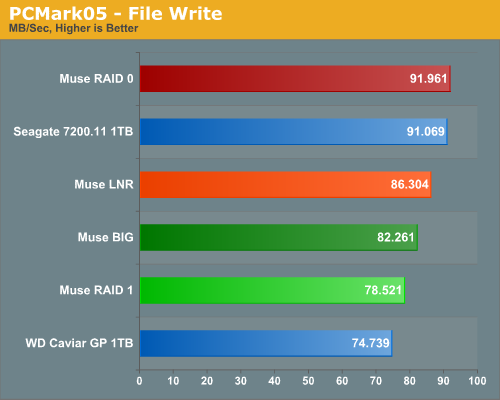
In almost all tests, the controller (ICH9R) on our Gigabyte P35-DQ6 motherboard outperforms the Muse. Even for the tests which are primarily based on pure throughput rather than seek performance (the file write and the virus scan tests), the Muse fails to take advantage of the second disk in its RAID 0 array, coming in basically at par with a single disk on the motherboard controller.
Linear mode, which is the disabling of all core functionality found in the Muse R-Duo, proves to be the best performing of the functions available. RAID 1 provides solid (though uninspiring) performance through all benchmarks, though we see the same 15-30% performance drop compared to a single drive consistently in our tests. Most disappointing is Big mode, which trails in almost all tests.
WinRAR
We have updated our WinRAR test methodology. We are now using a larger and more comprehensive directory structure (2.9 gigabytes, 154 files and 8 folders), and are using the "store" mode to eliminate the CPU as being a bottleneck in our testing. We run all tests three times to ensure consistency.
Our first WinRAR test takes our sample directory from the source WD Raptor drive and puts it in an archive on the test device. This is a good representation of a practical "write" test of the test device. We then take the newly created archive and uncompress it on the same drive. The second test therefore becomes a combination of read, write, and seek performance.
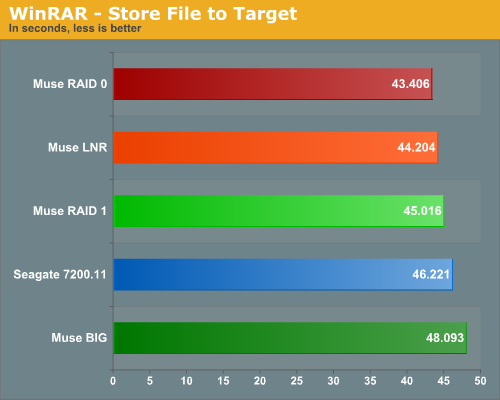
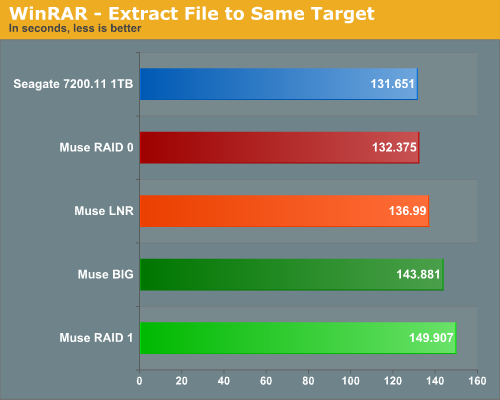
The Muse performs somewhat better in these benchmarks, though the overall transfer rate performance of the controller continues to be unimpressive. This is particularly obvious in WinRAR Test 1, where the RAID 0 configuration only slightly edges out the Linear (1 drive) configuration - this, in a benchmark which is basically the ideal showcase for RAID 0's transfer rate improvement. Big mode continues to be the slowpoke of the results in the test.
Windows Vista
Our stopwatch begins when we select Vista from the OS Choices menu at startup. We end when the login screen appears. We re-run the test three times, and take the average result of the three scores.
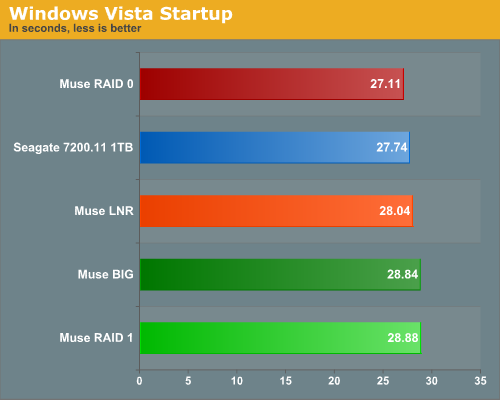
Vista Shutdown
For our shutdown test, we shut down Vista with no applications running. We run the test three times, and take the average result of the three scores.
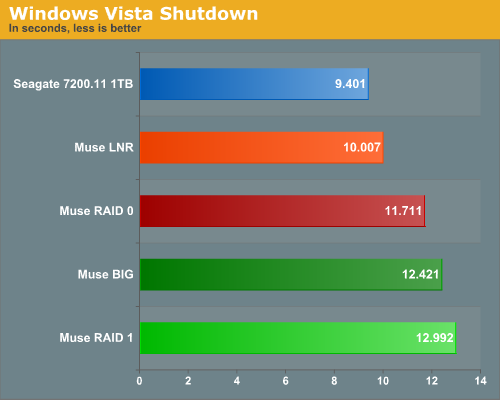
Again, performance is lower with the Muse than running a single drive, more noticeably during the shutdown test. RAID 0/1 and Big mode all perform worse than Linear mode.
PCMark Vantage
PCMark Vantage is the latest benchmark available from Futuremark, and requires on Windows Vista. Similar to the venerable PCMark05 in its makeup, Vantage modernizes the criteria and test methodology to reflect what users may encounter when running the most current Windows operating system. For the HD test suite, Futuremark breaks the tests down as:
- Windows Defender: Windows Defender performs a scan operation, resulting in a read-intensive (99.5% read, 0.5% write) benchmark reflecting a common task in Windows Vista.
- Gaming Performance: Measures streaming performance using actual game mechanics found in Alan Wake. This test is nearly all read (99.95% read, 0.05% write) in nature.
- Windows Photo Gallery: Windows Photo Gallery imports a large collection of images. This is the first of the tests which bring write performance into account in a meaningful way, with a roughly 84% read, 16% write ratio.
- Windows Vista Start-up: Simulates Windows Vista start-up operations, producing a test that breaks down to roughly 85% read and 15% write operations.
- Windows Movie Maker: This is the first Vantage test that comes close to equally dividing read and write operations (54% read, 46% write). It tests concurrent video performance for video read and skip performance, as well as video write operations.
- Windows Media Center: Performs the following three
tasks, with a result split equally between reading and writing.
- SDTV video playback
- SDTV video streaming to Extender for Windows Media Center
- SDTV video recording
- Windows Media Player: Windows Media Player adds a selection of music. This test reverts to favoring read operations (78% read, 22% write).
- Application Loading: Loads the following applications,
giving a benchmark divided as roughly 87% read, 13% write in nature.
- Microsoft Word 2007
- Adobe Photoshop CS2
- Internet Explorer 7
- Outlook 2007
We run each test five times per drive, producing an average score that we use for comparison in our charts. Our Vista strategy follows the one we're using for Windows XP: Apply only major milestone releases (SP1, SP2, etc.) except when absolutely necessary, and keep drivers updated when required. When a major driver (or OS) version is released, we will go back and re-run previous benchmarks to ensure that the data remains consistent. For our tests, we disable Windows Defender, set the paging file to a static 3.0GB size, and limit the Recycle Bin to 1GB maximum. We also close all desktop widgets.
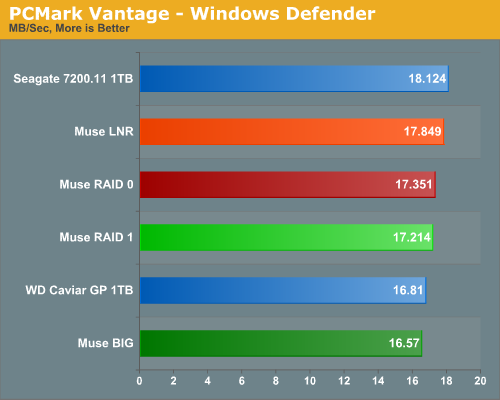
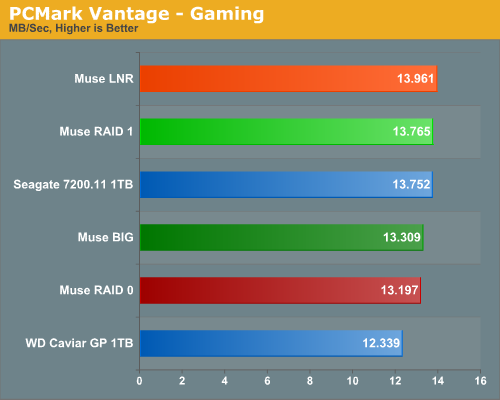
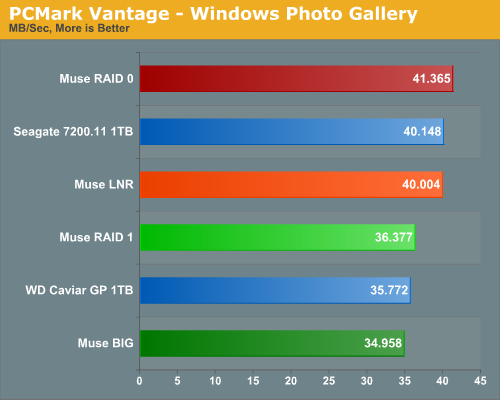
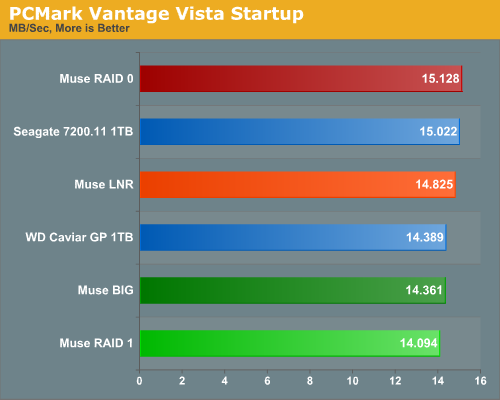
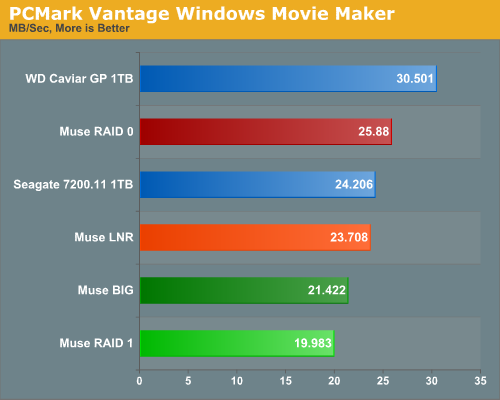
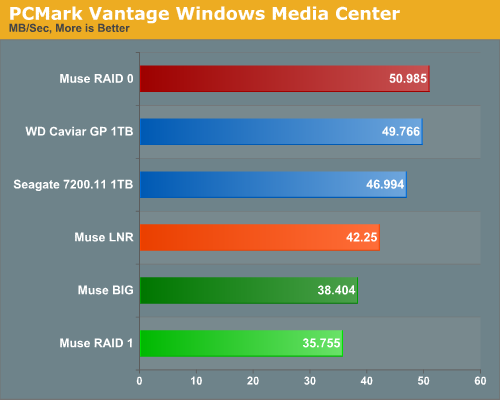
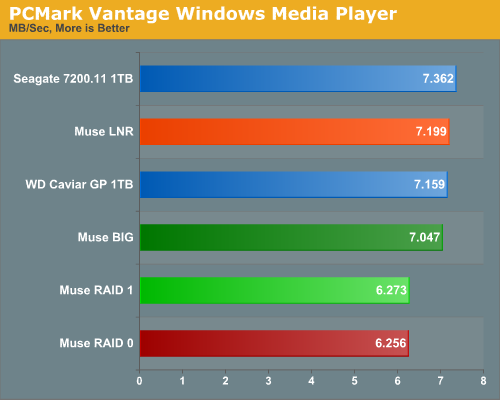
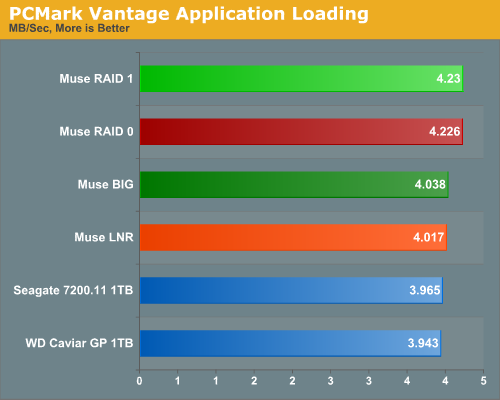
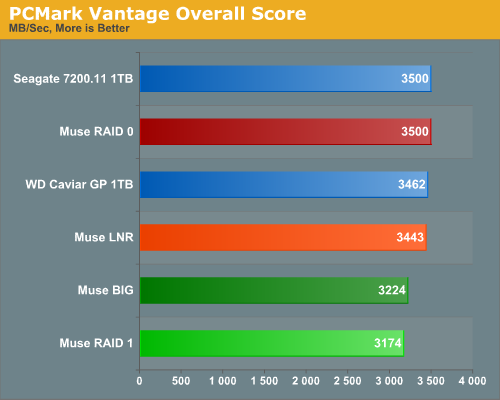
We find more of the same in our Vantage benchmarks. The Muse performs adequately as a single drive enclosure but poorly as a RAID controller. In PCMark Vantage, we don't see many of the really poor Big mode performance issues that we saw under XP, but the results scale more or less the same way.
RAID Reconstruction
An integral (though often untested) part of a RAID controller is how well it handles unexpected events. Hard drives fail and errors occur, but the base requirement of RAID arrays that incorporate redundancy into their design is that the system remains up and running. In addition to uninterrupted system activity, the length of time that it takes a system to rebuild the array (i.e. return to a non-degraded status) can be a critical factor in ensuring that the dreaded "multiple drive failure" scenario doesn't occur. The Muse R-Duo has only limited options for what RAID flavors it will allow, and only one of these options (RAID 1) has any redundancy at all. Therefore, the RAID controller error handling and reconstruction tests will focus on RAID 1 mode.
Error Handling
While not a test measurable by a simple graph, we took the array and did our best to make it unavailable by forcing a variety of random tests (i.e. randomly disconnecting and reconnecting power and data cables). In a RAID 1 configuration, the controller - under ideal circumstances - should simply continue to allow data access to the existing "good" drive, immediately failing the second ("bad") drive and removing it from its configuration.
In this instance, the Muse R-Duo handled drive removal without issue. The blue and red lights flash on the front of the drive bay that is empty, indicating that the drive is dead. Replacing the drive, however, immediately brought the Thermaltake enclosure down - a soft "power off" state of sorts, rendering the data inaccessible to the OS - though powering the unit off and on showed that the data was still intact. The RAID 1 operation was therefore performed adequately, but the puzzling behavior of the unit when a drive was put into the slot (ostensibly to rebuild the array) could certainly be better.
One other nice thing to note is that the Muse R-Duo is intelligent about recognizing when a hard drive has truly failed. We performed the following as test:
- Power off the enclosure
- Remove the drive
- Power on the enclosure (enclosure realizes that the drive isn't available for use, and fails it)
- Power off the enclosure
- Re-insert the drive
- Power on the enclosure
The Muse R-Duo is smart enough to do a quick version check on the data to see that a rebuild isn't necessary. If any data is written to the array while one drive is not present, however, the Duo-R considers the replacement drive "fresh" and will rebuild the entire array. In those rare instances where a disk fails to spin up properly on the first attempt, however, it's nice to see that the Muse R-Duo will avoid unnecessary rebuild operations.
RAID Reconstruction
After failure of a disk, it is important that the user replace the dead disk with a new drive as quickly as possible. It is then equally important that the RAID controller rebuild the array swiftly and without issue, so that the array returns to a normal, fault-tolerant (non-degraded) state.
For this test, we ran a PCMark Vantage benchmark loop with the array in a "degraded" state after removing one of the drives from our RAID 1 array. After the benchmark successfully ran in this degraded state twice, we installed a new disk and instructed the array to rebuild. We re-ran the benchmark during this rebuild operation and looked at performance as well as the length of time required to rebuild the array under two conditions. First, as a worst-case scenario, we ran PCMark Vantage in a loop while allowing the array to rebuild. We then failed the array again and allowed the rebuild to occur under more or less "idle" circumstances for a best-case scenario. In this case, the Muse R-Duo does the rebuilding on its own with no connection to a host computer.
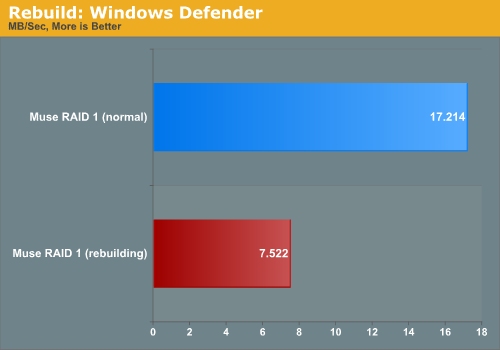
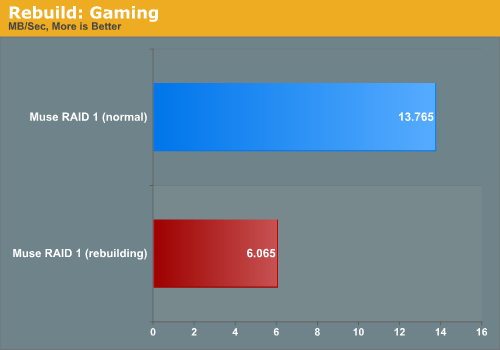
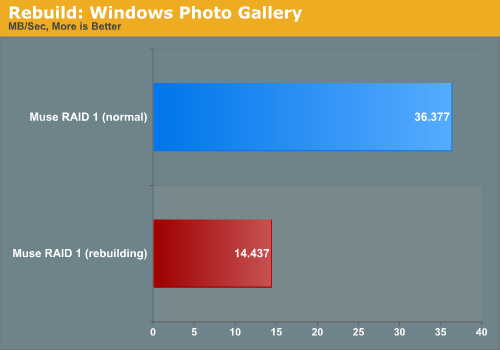
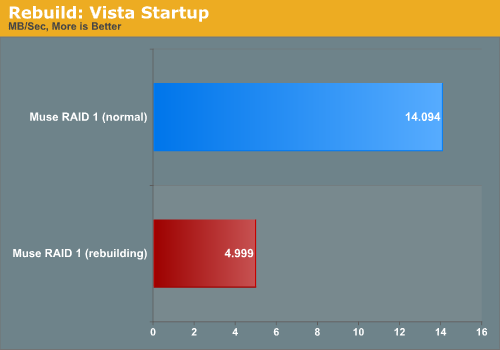
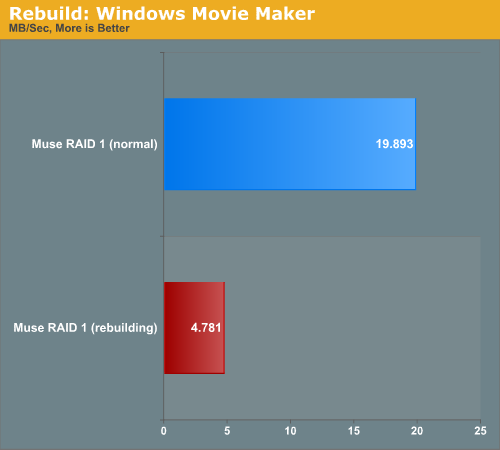
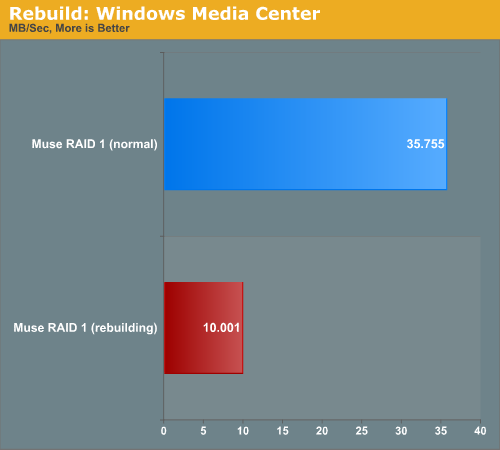
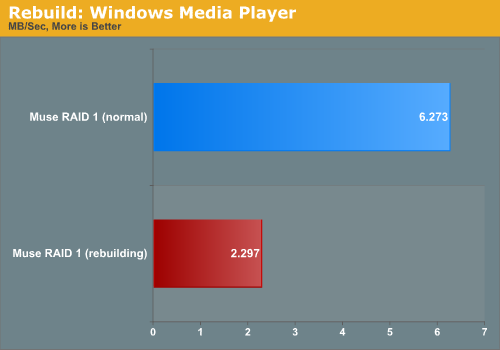
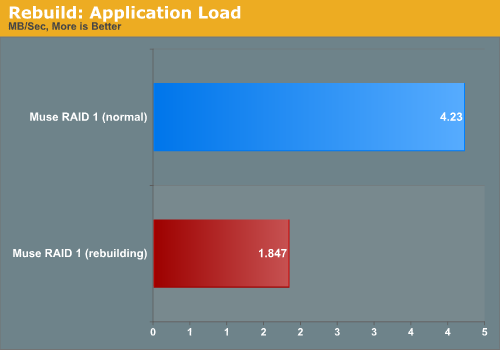
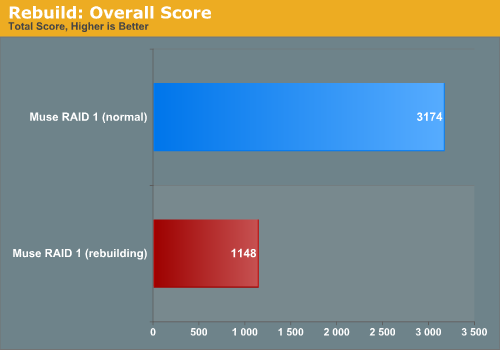
As expected, the Seagate slows to a crawl while the drive is busy reading data to restore the mirrored copy. As the number of RAID products we review grows, there will be a difference in the performance of the drive during rebuild. Remember, the performance and rebuild operation time are both important factors in a system relying on RAID for uptime. (For data retention, regular backups are necessary!) The rebuild operation took 6 hours and 54 minutes for a 1TB mirrored volume under ideal circumstances (detached from the host system). Under normal circumstances, however, where the host OS is going to be reading from and writing to the drive, the rebuild will take substantially longer.
Conclusion
Thermaltake's Muse RAID R-Duo is an interesting product, with a very fuzzy target market. RAID, in itself, is a hotly disputed topic, with many people (including most members of the AnandTech staff) asking if it deserves a place in the desktop market at all, given the questionable benefits available. There's absolutely no question that RAID is an integral part of any business server. Beyond that, the picture becomes far less clear.
In the case of an enterprise-class RAID application, two things are required: Data security and performance. The Muse R-Duo provides the former without complaint, as the RAID 1 array continues to function when running in degraded mode. The array appears to have rebuilt without issue, though this wasn't always clear: There's no companion application available for the Muse to indicate that the rebuild was successful. The only way to verify that the array rebuild is complete is to watch the activity light, then once the activity ceases pull the other drive from the enclosure to confirm that the array still functions. This is a problem, to say the least - IT administrators with little time on their hands aren't going to be happy about sitting there waiting for an activity light to change color.
Performance-wise, the Muse R-Duo is below average. The RAID controller onboard the Muse R-Duo keeps CPU usage down on the host machine, which is excellent, but actual I/O performance is lacking. In any I/O intensive application, certainly, the Muse will likely be quickly overwhelmed. For desktop users, RAID 1 functions as advertised, though the user "wins" a lower performing hard drive if they choose to employ this function.
Things aren't all bad for the Muse. Setup is extremely easy, with only a couple of button presses required to configure an array. Portability is flawless - we were able to move the drive between machines, and new systems recognize the enclosure as an "external hard drive" without issue. The enclosure itself, while not dazzling, isn't unattractive by any means, and the noise emanating from the case is very low even under high levels of activity. It also dissipates heat efficiently with the tiny fan and aluminum construction.
In our next storage article, we'll take a closer look at one of the more popular onboard RAID solutions so that you can judge for yourself which solution makes the most sense in the performance user/entry-level business space. Perhaps the Muse R-Duo is indeed the RAID solution for you, despite its shortcomings. However, it's best to measure these shortcomings compared to the "entry-level" solutions which most of us already have on our motherboards, so stay tuned for our follow-up article.







